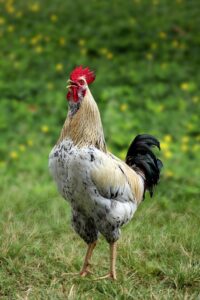Whether you’re a seasoned homesteader, a backyard chicken keeper, or just starting your flock, managing a rooster can seem a little, well, intimidating. Is he the protector of the coop or just a noisy troublemaker? Should you keep him for breeding or consider alternatives? Buckle up, chicken enthusiasts—we’re about to break down everything you need to know about successful rooster management (without losing your sanity—or your hens!).
Rooster 101: What Role Does He Play in Your Flock?
Roosters aren’t just there to crow at 5 a.m. and keep you from sleeping in. They’re essential to a balanced flock (unless you prefer an egg-only operation). Here’s what they bring to the table (or the coop):
Reproduction
If fluffy chick cuteness is your goal, you’ll need a rooster in the mix. Without him, those eggs your hens lay will just be tasty breakfasts—not the beginning of new chicks.
Protection
Roosters are the knights of the flock, always on the lookout for predators. Whether it’s hawks, foxes, or even your neighbor’s overly curious cat, a good rooster will sound the alarm and protect his hens at all costs. (Sometimes this makes them a little… over-protective with humans, but don’t worry—we’ll tackle that later.)
Social Organization
Ever heard the phrase “pecking order”? Your rooster didn’t just create it; he enforces it! By maintaining harmony and order, a rooster ensures everyone in the flock sticks to their role.
Breed Matters
Not all roosters are created equal. Some breeds, like Silkies and Buff Orpingtons, are known for their calm demeanor, making them great for beginners. High-energy breeds like Rhode Island Reds or Leghorns may require extra management and oversight.
Choosing Your Rooster
When selecting a rooster, look for calm, confident behavior rather than aggression. You want a leader, not a dictator. And if you’re choosing between multiple roosters, keep reading for tips about managing more than one!
Understanding Flock Hierarchy
Roosters are all about that hierarchy life—it’s how they keep their flock running smoothly.
Pecking Order
When you introduce a rooster, your flock will naturally establish a “pecking order.” While this sounds cute, it’s a serious business in chicken society. Your rooster will likely sit at the top of the order, with hens below him in rank.
Dominance Behaviors
Ever see a rooster puff out his chest or do a funky little dance? That’s him asserting dominance, showing the hens he’s the boss. Sometimes, though, this “charm” can feel more like intimidation—especially if you’re on the receiving end of a protective peck.
Communication and Conflict
Chickens do communicate, even if it’s not in words. A good rooster uses soft clucks to attract hens to food or squawks to warn of danger. If conflict arises within your flock, your rooster will often step in to mediate (or at least make the whole drama slightly more bearable).
Rooster-to-Hen Ratio
Ah, the golden question—how many hens per rooster?
Optimal Ratios
The standard rule? Keep one rooster for every 8–12 hens. Too many roosters and you’re asking for constant fights. Too few hens and you risk wear-and-tear on your hens (literally).
Overmating Concerns
An overzealous rooster can lead to overmating, which can stress your hens and even cause injuries like feather loss or scratches. Watch your flock closely and separate the rooster temporarily if he’s getting a little too frisky.
Hen Health
Keeping the right ratio minimizes stress and ensures that your hens stay happy, healthy, and productive. Because, honestly, nobody wants egg mutiny.
Handling Rooster Behavior
Not all roosters are sunshine and rainbows. Sometimes they’re more like little feathered rebels.
Spotting Aggression
A rooster who flares his neck feathers, charges, or jumps at you needs a behavior check. While it’s common for roosters to protect their hens, you don’t want aggression aimed at people.
Training Techniques
Yes, you can train a rooster! Stand your ground, gently redirect his behavior, and—as silly as it sounds—walk confidently into the coop to show you’re the boss.
Handling Strategies
Pick up your rooster occasionally (safely, of course) to reinforce that you’re no threat. This can also help him grow accustomed to handling, which is useful for routine health checks.
Managing Territorial Tendencies
Roosters are territorial by nature, especially during mating season. Give him enough space for his hens, and provide separate hiding spots for hens who need a break.
Multiple Rooster Dynamics
Got more than one rooster? You’re in for a challenge, but it’s not impossible to create harmony.
Introducing Roosters
Introducing new roosters is tricky—they’ll likely fight to sort out hierarchy. Introduce them slowly and carefully, using barriers if needed to prevent full-blown brawls.
Conflict Management
Even established roosters may clash at times. Monitor them closely and separate as needed, giving them time to chill out before rejoining the flock.
Legal and Neighborhood Considerations
Before inviting a rooster into your homestead, make sure you’re following local guidelines.
Noise Management
Roosters are loud. If you’ve got neighbors nearby, consider sound-dampening techniques like coop insulation or setting up a dark, quiet space to delay early-morning crowing (yes, it works—sometimes).
Local Regulations
Not all areas allow roosters. Before you accidentally cause a neighborhood uproar, check your local laws to keep things peaceful.
Breeding and Health
A healthy rooster means a healthy flock.
Health Monitoring
Check your rooster regularly for signs of illness, such as lethargy, abnormal droppings, missing feathers, or changes in appetite. A quick health check every week can save you time and stress in the long run.
Fertility Management
If breeding is your goal, track fertility rates and ensure your rooster isn’t past his prime (yes, their fertility decreases with age).
Selective Breeding
If you’re running a breeding program, choose roosters with desirable traits, such as calm temperament and good genetics, to pass on to future generations.
End-of-Life Decisions
Sadly, roosters don’t live forever. When it’s time to say goodbye, plan accordingly.
Retirement Options
Older roosters who are no longer breeding can be retired to a “rooster-only” coop or given to farms willing to care for them.
Humane Management
For those managing larger flocks, occasional culling of aggressive or unhealthy roosters may be necessary. Always prioritize humane methods.
Wrapping Up
Managing a rooster can be challenging, but it’s also incredibly rewarding when done right. With the right balance of behavior management, health monitoring, and flock dynamics, your rooster will be not only the protector of your coop but a valuable asset to your homestead.
Have any fun or challenging rooster stories you’d like to share? Drop them in the comments below! Or, if you’re facing a rooster conundrum we didn’t cover here, reach out—we’re here to help.
And remember, happy roosters mean happy hens, and happy hens mean plenty of eggs (and fewer headaches)! 🐓
For more on chicken care:
Chicken Egg Collection, Cleaning and Storage
Fermenting Herbs for Chicken Gut Health
Chicken Foraging and Free Ranging
Best Chicken Breeds for Egg Laying
Safely Introducing New Hens to Your Flock

